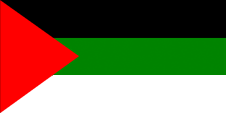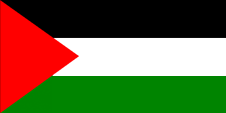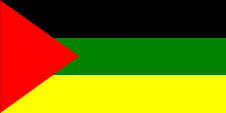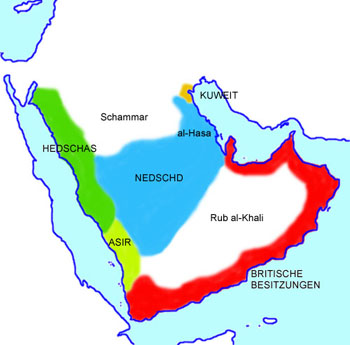mobile View, to the German Version tap the flag


- also: Hedjas, Hijaz
- former Emirate and Kingdom along the Red Sea
- today part of Saudi Arabia and separated in some provinces
- own name: Al-Hidjaz
• Flags
• Meaning/Origin of the Flag
• Map
• Numbers and Facts
• History
• Origin of the Country's Name

1916–1917,
Flag of Hejaz,
Source, by:
World Statesmen




1917–1920,
Flag of Hejaz,
Source, by:
World Statesmen




1920–1926,
Flag of Hejaz,
Source, by:
World Statesmen




1926–1932,
Flag of Hejaz,
Source, by:
World Statesmen




Over Hejaz ruled since centuries the Sherifs of Makkah from the dynasty of the Hashemits which has its roots in Haschim ibn Abd al-Manaf, the grandfather of Mohammed. This changed not under the supremacy of the Ottoman Empire, to which Hejaz belonged since 1517. In the First World War the Arabs would jettison the yoke of the Turks and startet with British support the Arabian Revolt in Hejaz. Sherif Hussain I. took over the top of the movement, which started the struggle under a red flag – the colour of the Hashemits. Already in the year 1911 the Arabs agreed that the "Arabian Flag" has to carry the colours white, black, green and red. Red is the colour of Omar, the second calif; white stands for the Omajiades, a calif-dynasty, which goes back to the fifth calif Moawija I.; green stands for the Fatimides, a ismailitic-shiit calif-dynasty, which goes back to the fourth calif Ali; and black stands for the Abbasides, a calif-dynasty, which goes back to the Abbas I., Calif. Sherif Hussain I. adoped these four colours on 30th of May 1917 in a flag with three horizontal stripes in the order of black, green and white, but supplemented it by the colour of his dynasty with a red triangle at the leech. The flag of the Arab Movement was born. The order of the horizontal stripes of the flag was changed in 1920 in black, white and green. The during the First World War liberated Arabian territories (Syria, Jordan and Iraq) became after the war – sometimes only for short times – kingdoms under the reign of the sons of Hussain I. In Jordan rule the Hashemits until today. This young Arabian states adoped all for their flags the colours of the flag of the Arabian Revolt. The "Panarabian Colours" were born. In the course of times arised even some states more which as well use flags in this colours (e.g. Kuwait, Palestina, Sudan). As Ibn Saud Abdul-Asis III. – the Sultan of Nadjd – which conquered Hejaz between 1921 and 1925 was crowned to the King of Hejaz in the year 1926, the order of the horizontal stripes in the flag of Hejaz was changed once more, in black, green and yellow, probably to defamiliarize consciously the Panarabian Colours, to make the flag more distinctionable from the flags of the neighbouring Arabian states because in this countries still ruled the Hashemits. As in the year 1932 the State of Saudi-Arabia was formed by the unification of Hejaz and Nadjd the flag of Hejaz was abolished although Hejaz existed some years further as province.
Source:
Die Welt der Flaggen,
Wikipedia (D),
Wikipedia (EN)

clickable Map of the Arabian Peninsula about 1920:

Source: Volker Preuß

Area: ca. 193.000 square miles
Inhabitants: 900.000 (1925)
Capital: Meccah (Makkah), 1924–1926 Jeddah
Currency: 1916-1925, Hejazi Riyal (SAA)
Source: World Statesmen,
Volker Preuß

1201 · establishment of the dynasty of the Hashemits in Hejaz as Sherifs of Makkah, the Hashemits descend from Haschim ibn Abd al-Manaf, a grandfather of Mohammed
1258 · Hejaz becomes a part of the Empire of the Mameluks (Egypt)
1517 · conquest of Hejaz by the Ottoman Empire, recognition of the Turkish supremacy by the Hashemite Sherifs of Makkah
1819–1840 · to the Empire of Mohammed Ali (Egypt), thereafter under Turkish supremacy again
1914–1918 · First World War, the Ottoman Empire fights at the side of the Middle Mights against the Entente: 1914–1918 partisan war of the Arabs against the Turks in Hejaz with British support
10th of June 1916 · proclamation of the Hashemite Kingdom of Hejaz by Hussain I. the Sherif of Makkah
19th of October 1916 · Hussain I., King of Hejaz, proclaims the independence of the Arabs from the Ottoman Empire
10th of October 1920 · Treaty of Sèvres, Turkey recognizes the independence of Hejaz
1921 · Faisal I. – son of von King Hussain I. – becomes King of Iraq (until 1958), the Emirate of Nadjd begins with the conquest of Hejaz
24th of July 1923 · Treaty of Lausanne, Turkey confirms the independence of Hejaz
1923 · Abdullah – son of von King Hussain I. – becomes Emir of Trans Jordan (the Hashemits reign there until today)
1924 · troops of the Saudi Emirate of Nadjd conquer Taif and Makkah
1924 · King Hussain I. hands over the throne in Makkah to his son Ali and goes to Aqaba
1925 · troops of the Saudi Emirate of Nadjd conquer Madinah
19th of December 1925 · King Ali disclaims the throne and flees from the troops of the Saudi Emirate of Nadjd to Jiddah, Hejaz becomes complete occupied by Saudi troops except Jiddah, end of the Hashemite Kingdom of Hejaz
23th of December 1925 · troops of the Saudi Emirate of Nadjd occupy Jiddah
8th of January 1926 · coronation of Ibn Saud Abdul-Asis III., the Sultan of Nadjd, to the King of Hejaz
19th of January 1927 · coronation of Ibn Saud Abdul-Asis III. to the King of Nadjd and Hejaz
20th of November 1930 · the Emirate of Asir becomes governmentally affiliated to Hejaz
18th of September 1932 · formation of the Kingdom of Saudi Arabia by unification of the Kingdom of Hejaz with the Kingdom of Nadjd
Source:
World Statesmen,
Atlas zur Geschichte,
Discovery '97

The Arabian word "Hedjas" means "valley of a rivulet", a term which is impressed on since many years for the whole western coast of the Arabian Peninsula. Originally was with it meaned a by valleys drawed through landscape (Al-Hidjaz) 95 miles western of Madinah in the uplands of Dshebel al-Higaz. Possibly the term "Hedjas" spreaded out wit the expansion of the territories of influence of the Sherifs of Makkah along the coast of the Red Sea.
Source:
Volker Preuß


![]()






